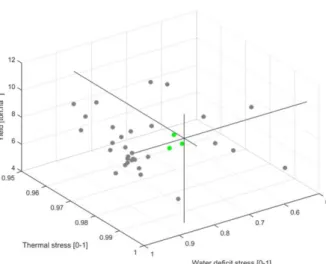Ecotron : a unique facility to study the impacts of climate change.
Improving the experimental design using crop modelling to
determine the meteorological conditions to be implemented
Dumont B.
1,*, V. Leemans
2, S. Garré
3, R. Hamdi
4, L. Decruz
4, B. Heinesch
3, P. Delaplace
1& B. Longdoz
3.
Introduction
Material & Methods
An Ecotron is a facility where ecosystems are confined in experimental chambers, allowing the simultaneous control of environmental conditions and the on-line monitoring of processes. Under the threats of climate change and the pressure of a world growing population, such facilities will be of major importance to study the relations between climate change and agro-ecosystems.
As it can quickly become time- and money-consuming, conducting experiments in an Ecotron will force researchers to cautiously select the climate of interest to be generated. They will thus need reliable tools to help them support the decision making process. Here, we present an innovative methodology, supported by the use of crop model, to assist researchers in finding the climatic conditions under which crop services will be impacted.
.
Meteorological dataset
The meteorological datasets among which the
choice can be done were generated by the
ALARO-0 model (RMI, Belgium) for current and future climatic conditions [2].
Runs were conducted for the historical period (1981-2015), and for two time frames (2041-70 and
2071-2100) under two emissions scenarios
(RCP 4.5 and 8.5).
The Ecotron growing chambers
Results
Using crop model outputs within the proposed methodology, a novel multi-criteria approach was designed to retro-select the specific climatic conditions allowing to reach certain outcomes (e.g. yield target) while simultaneously exhibiting given thresholds of stresses for any considered crop stages.
Conclusions
Figure 4: Output of the methodology to select the climatic conditions to be
implemented within the Ecotron facility – Yield response as a function of the average thermal and water deficit stresses during reproductive phase. The grey dots are the closest climatic year matching the targeted percentile.
1. Dpt. Terra & AgroBioChem, ULg-GxABT, Belgium, 2. Dpt. Terra, EnvironmentIsLife, ULg-GxABT, Belgium, 3. Dpt. Terra & BIOSE, ULg-GxABT, Belgium,
4. Royal Meteorological Institue of Belgium, Brussel, Belgium;
5. * Passage des Déportés, 2, 5030 Gembloux, Belgium. @: Benjamin.dumont@ulg.ac.be
Authors affiliation
1.http://www.gembloux.ulg.ac.be/ur-terra/
2. Gio et al., 2016, Validation of the ALARO-0 model within the EURO-CORDEX framework. Geoscientific Model Development, 9(3):1143-1152
3. Brisson et al. 2009. Conceptual Basis, Formalisations and Parameterization of the Stics Crop Model. Editions Quae.
References
Interaction Crop model - Ecotron
A soil-crop model(STICS, INRA, FR, [3]) was run over the entire climatic dataset.
Crop model outputs are then synthesized for the main crop phenological phases, i.e. the juvenile, vegetative and reproductive phases.
Here, the emphasis is put on agronomical outputs (biomass and grain yield) and crop growth stresses (deficit and excess of water, thermal and nutrient stresses).
Target percentiles are define for each of the variables of interest.
A global criteria is computed using a computation function that is similar to a Mahalanobis distance. Finally, the procedure returns a predefined number of climate that achieve the highest score regarding the criteria.
Figure 3: Schematic procedure of climatic year selection. The users
can define the percentile of interest regarding the climatic variables themselves or the model outputs. The corresponding climatic conditions can then be implemented within the facility
Figure 3 presents the two paths to
select a climatic year to be
implemented within the Ecotron. The user can base his choice purely on the climatic variables or on the crop model simulations.
In this example, we selected three variables of interest : i) the final grain yield, ii) the average thermal stress and iii) the average water deficit stress during grain filling, as simulated by the STICS model on the historical set.
The targeted percentile were 0.8, 0.3 and 0.8, respectively for the yield, water deficit and the thermal stress (straight black line on Fig. 4).
The methodology allows to retro-select the climatic year matching the criteria (green dots on Fig. 4) within the complete database of results obtained on the 35 cropping season simulated (grey dots on Fig. 4). Climate chambers :
Control of the climatic parameters and fluxes : Irradiance – T°- Humidity – Precipipation – [CO2] – [O3]
Soil containers :
Control of the soil parameter and fluxes : Heat – Humidity – Micro-organisms
Figure 1: Outline of one
of the growing chambers implemented within the Ecotron [1]
Figure 2 : Schema of the ALARO-0 concept, illustrating the
continuous transition from ARPEGE/ALADIN to ALARO-0 (3-7km mesh size) Climatic database User’s choice : Definiton of percentiles of interest
